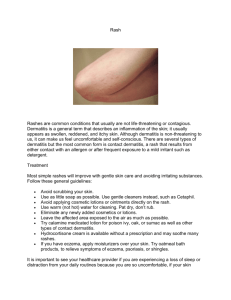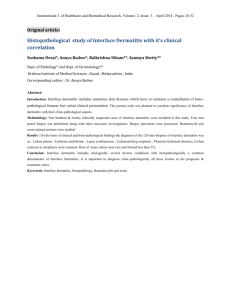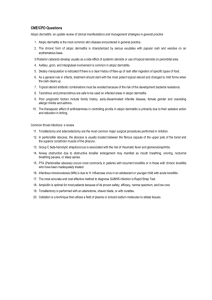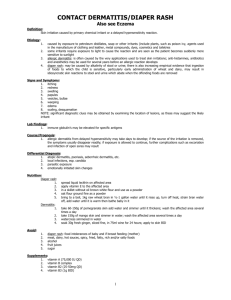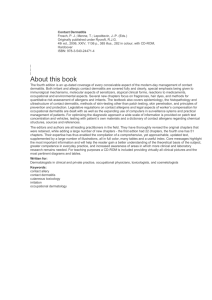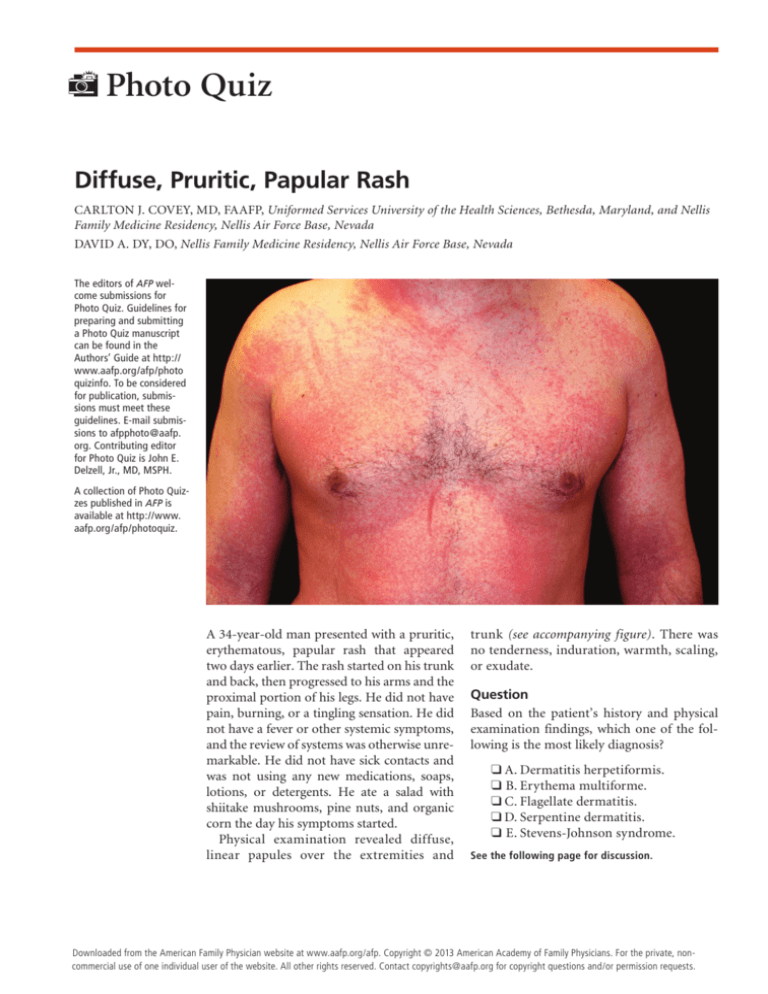
Photo Quiz
Diffuse, Pruritic, Papular Rash
CARLTON J. COVEY, MD, FAAFP, Uniformed Services University of the Health Sciences, Bethesda, Maryland, and Nellis
Family Medicine Residency, Nellis Air Force Base, Nevada
DAVID A. DY, DO, Nellis Family Medicine Residency, Nellis Air Force Base, Nevada
The editors of AFP welcome submissions for
Photo Quiz. Guidelines for
preparing and submitting
a Photo Quiz manuscript
can be found in the
Authors’ Guide at http://
www.aafp.org/afp/photo
quizinfo. To be considered
for publication, submissions must meet these
guidelines. E-mail submissions to afpphoto@aafp.
org. Contributing editor
for Photo Quiz is John E.
Delzell, Jr., MD, MSPH.
A collection of Photo Quizzes published in AFP is
available at http://www.
aafp.org/afp/photoquiz.
A 34-year-old man presented with a pruritic,
erythematous, papular rash that appeared
two days earlier. The rash started on his trunk
and back, then progressed to his arms and the
proximal portion of his legs. He did not have
pain, burning, or a tingling sensation. He did
not have a fever or other systemic symptoms,
and the review of systems was otherwise unremarkable. He did not have sick contacts and
was not using any new medications, soaps,
lotions, or detergents. He ate a salad with
shiitake mushrooms, pine nuts, and organic
corn the day his symptoms started.
Physical examination revealed diffuse,
linear papules over the extremities and
trunk (see accompanying figure). There was
no tenderness, induration, warmth, scaling,
or exudate.
Question
Based on the patient’s history and physical
examination findings, which one of the following is the most likely diagnosis?
❑ A. Dermatitis herpetiformis.
❑ B. Erythema multiforme.
❑ C. Flagellate dermatitis.
❑ D. Serpentine dermatitis.
❑ E. Stevens-Johnson syndrome.
See the following page for discussion.
◆ Volume 88, Number 9
November 1,
2013
www.aafp.org/afp
American Academy of Family
American
Family
605
Downloaded
from
the American
Family Physician website at www.aafp.org/afp.
Copyright © 2013
Physicians.
For thePhysician
private, noncommercial use of one individual user of the website. All other rights reserved. Contact copyrights@aafp.org for copyright questions and/or permission requests.
Photo Quiz
Discussion
The answer is C: flagellate dermatitis. Flagellate dermatitis is a diffuse rash that most commonly occurs after
exposure to the chemotherapeutic agent bleomycin, but
it can also occur with shiitake mushroom ingestion.1,2 It
presents as multiple linear, pruritic papules that become
erythematous with excoriation. The rash is often located
on the extremities and trunk. Similar cutaneous manifestations occur in patients with dermatomyositis, Still’s
disease, and human immunodeficiency virus infection.2
The diagnosis of flagellate dermatitis is clinical and
based on the history and appearance of the rash. The
dermatitis usually begins within the 24 to 48 hours after
ingestion of raw or partially cooked shiitake mushrooms,
and has an average duration of eight days.2 In contrast,
symptoms associated with bleomycin use occur up to
nine weeks after initial exposure and can last up to six
months after discontinuation.1,2 The rash is treated by
eliminating exposure to the causative agent, and with
topical and oral steroids and antihistamines. Patch testing
is not recommended, and skin biopsies are nonspecific.2
Dermatitis herpetiformis is an intensely pruritic
papulovesicular rash on the trunk and extremities.
Summary Table
Condition
Characteristics
Dermatitis
herpetiformis
Intensely pruritic papulovesicular lesions
on the trunk and extremities; associated
with celiac disease
Target-shaped lesions on the hands,
soles, and extremities; usually appears
after exposure to certain medications or
viral infections
Multiple linear, pruritic papules often
on the extremities and trunk that
become erythematous with excoriation;
associated with shiitake mushroom
ingestion or bleomycin use
Hyperpigmented rash that follows an
underlying vein proximal to an infusion
site; associated with intravenous
administration of chemotherapeutic
agents, most commonly fluorouracil
Skin blistering, and sometimes
desquamation; involves mucosal
areas, especially the mouth and lips;
associated with certain viral infections
and antibiotic use
Erythema
multiforme
Flagellate
dermatitis
Serpentine
dermatitis
StevensJohnson
syndrome
606 American Family Physician
It is an autoimmune disease with a clear association
to celiac disease and gluten sensitivity. Only 15% of
patients with the rash have digestive manifestations of
celiac disease.3 Both entities have similar pathophysiology and subsequent gluten-sensitive enteropathy. The
rash dissipates with withdrawal of gluten from the diet.
Erythema multiforme usually manifests as targetshaped lesions on the hands, soles, and extremities. It
is the result of a type IV hypersensitivity reaction to
an infection, connective tissue process, or medication
use (classically nonsteroidal anti-inflammatory drugs,
antiepileptics, sulfonamides, or antibiotics), or it can be
idiopathic.4
Serpentine dermatitis is associated with intravenous
administration of chemotherapeutic agents, most commonly with fluorouracil. The rash has a similar morphology to flagellate dermatitis, but with a hyperpigmented
pattern that follows an underlying vein proximal to an
intravenous infusion site.5
Stevens-Johnson syndrome is a more serious and
possibly life-threatening form of erythema multiforme.
It can lead to skin blistering and possibly desquamation, and involves mucosal areas, especially the mouth
and lips. Fever, malaise, and upper respiratory tract
symptoms are common in the days preceding StevensJohnson syndrome. The condition is commonly associated with use of certain medications, especially antibiotics and sulfa drugs, but can also be triggered by viral
infections, such as herpes simplex virus, influenza, and
Epstein-Barr virus.4
The opinions and assertions contained herein are the private views of
the authors and are not to be construed as official or as reflecting the
views of the U.S. Air Force Medical Department or the U.S. Air Force at
large.
Address correspondence to Carlton J. Covey, MD, FAAFP, at carlton.
covey@us.af.mil. Reprints are not available from the authors.
Author disclosure: No relevant financial affiliations.
REFERENCES
1.Diao DY, Goodall J. Bleomycin-induced-flagellate dermatitis. CMAJ.
2012;184(11):1280.
2.
Girard C, Bessis D. Flagellate dermatitis. Arch Dermatol.
2012;146(11):1301-1306.
3.Ingen-Housz-Oro S. Dermatitis herpetiformis: a review [in French]. Ann
Dermatol Venereol. 2011;138(3):221-227.
4.Exanthems and drug eruptions. In: Habif TP, ed. Clinical Dermatology:
A Color Guide to Diagnosis and Therapy. 5th ed. New York, NY: Mosby;
2010:541-580.
5.Pujol RM, Rocamora V, Lopez-Pousa A, et al. Persistent supravenous
erythematous eruption: a rare local complication of intravenous 5-fluorouracil therapy. J Am Acad Dermatol. 1998;39(5 pt 2):839-842. ■
www.aafp.org/afp
Volume 88, Number 9
◆
November 1, 2013

